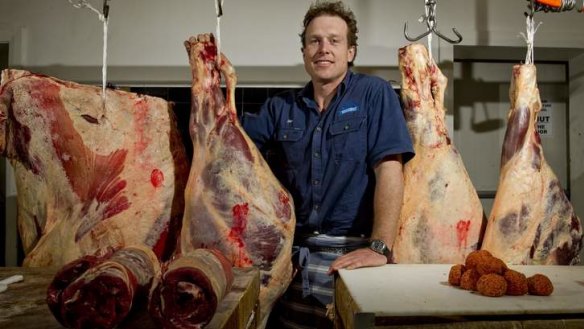New-age beef graziers: The butcher
Australia’s cattle pioneers became known as kings in grass castles. But farming today has become more challenging than feeding livestock, thanks to the dominance of supermarkets and multi-nationals. In a two-part article, <b>John Thistleton</b> meets the next generation who need to diversify. Here, in part two, Sam Burton Taylor at Boorowa reveals why he runs a butcher shop to sell his own meat.

From a 1926 shop in Boorowa's main street, farmer Sam Burton Taylor is sharpening his knowledge of the Australian meat industry to make sure he gets the best possible price for his beef.
He bought the shop with ornate high ceilings three years ago and began a butcher's apprenticeship. Two solid timber chopping blocks stand in front of a wall of gleaming tiles as black as his family's young angus bulls.
His father Nick Burton Taylor's Kenny Creek Stud sells 450 bulls a year to producers around Australia. It is from these farms that Burton Taylor buys his cattle. They wade through and eat down Triticale crops and in late spring fatten on phalaris and chicory grass and clover.
When coupled with genetics, Burton Taylor says his angus herd flourishing on the undulating hills between Boorowa and Cowra makes meat superior to any grain-fed animal at the premium end of the market.
Burton Taylor has taken control of his product, delivering directly to butchers and wholesalers in Sydney and Canberra, instead of relying solely on what he's paid at the saleyards.
He has just completed his last formal exam as a 35-year-old butcher's apprentice to focus on his carcasses' full value.
A little guy trying to get their product into the market is very difficult,'' he says. ''You don't see farmers market suppliers growing beyond those markets.
''One of the great challenges in our industry is we are dominated by duopolies. We have Coles [and Woolworths], as an end user and they control kill space and retail space,'' Burton Taylor says.
''And the two largest processors in Australia are foreign owned, Cargills and JBS.''
He is able to kill and process his meat at Cootamundra, but it's a tenuous link to a dwindling number of major processors who often won't offer a service to anyone else except themselves.
''A little guy trying to get their product into the market is very difficult,'' he says. ''You don't see farmers market suppliers growing beyond those markets.''
For Burton Taylor the move to the butcher shop is not a question of financial survival, since his stud was already profitable. Rather, it's about keeping control of his own prices and livelihood. But the path he's chosen is not without challenges.
''Beef is the hardest to get right, one because it is so slow growing, and two because there is a mix of cuts. In a typical animal we'd use up to 15 per cent of the animal, your sirloins, scotch fillet, your rumps, eye fillet, and you have another massive amount that you have to move through other avenues which are not your premium cuts and much harder to brand.''
From a 200-kilogram animal a butcher will get 20 kilograms of sausages, 30 kilograms of mince, and numerous other products that need a buyer.
An estimated 14,000 vehicles from the north of NSW head south through Boorowa and past Sam's Paddock butcher shop, but the owner is casting his net much wider, to Canberra, restaurants and butchers in Sydney and, longer term, China. He knocks on doors to sell meat with Kenny Creek beef's catchphrase, ''never ever''.
''It's never been fed on grain, it's never been given hormones,'' he says. ''There's definitely a movement for those who are health conscious, who are enthusiastic meat eaters, to go back to grass. Whereas 10 years ago, grain was seen as the premium product.''
He says grass is healthier, high in omegas. ''It's a little bit tougher to eat because the animal has to typically work harder for its food, but it's got better flavour and is better for you.
''And we know we can produce consistently high-grade beef throughout the year. It doesn't sound much, but that's the challenge, doing it day in, day out, and having quality of beef whether you are at the end of summer or end of the winter.''
The family's angus studs at Hillgrove and Breakfast Creek Station were previously typical wool-country farms on soft, loamy soil, carrying up to 50,000 sheep, until they switched solely to beef.
''That's the beauty in Canberra, we are so spoilt for choice, we are in one of the great food bowls of Australia and a lot of things we source are so far afield,'' Burton Taylor says.
''Bringing Tasmanian beef in seems ridiculous when we've got some of the best grass-fed beef in the area and my wholesaler was saying to me he can't source grass-fed beef from anywhere in the region other than ours.''
Burton Taylor says Meat Standards Australia has graded his beef in a boning group of 1 and 2, among the highest gradings in Australia, and a potent counter to the slick retailing skills of the major chains who use petrol dockets, discounts and bonus points to corner their markets.
Article one: The chook farmer
>> John Thistleton is a staff writer.
Restaurant reviews, news and the hottest openings served to your inbox.
Sign up